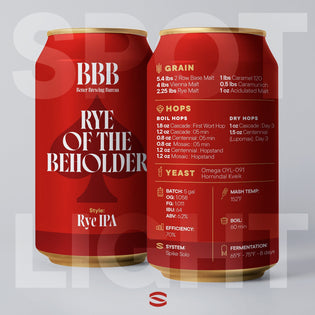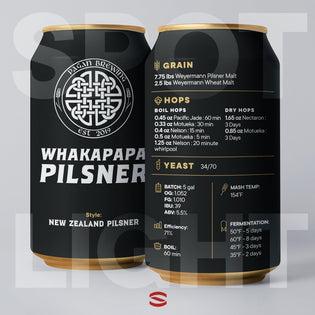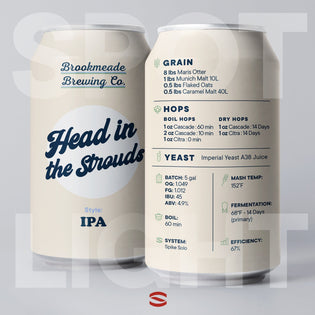
The Brewer: Windy Bridges Brew
Hi, I'm Marcus from Windy Bridges Brew. I started brewing five years ago and fell in love with the hobby. I started out with a 1-gallon Brewers Best kit, a pot, and the stove, but all you really need to get started is a good brew kettle.
Fast forward, I have received my level 1 cicerone certificate and a scholarship to Point Park University for their brew science course. I'm also an assistant brewer at Inner Groove Brewing.
The name Windy Bridges Brew comes from me being born and raised in Chicago and moving to Pittsburgh. Which also is reflected in my logo with the 16th street bridge and the Willis tower in the background.

Purchasing the CF10 Conical Unitank has elevated my game tremendously. Being able to use the same equipment I use at the brewery makes the transition very easy.
If I had one piece of advice it would be to ask as many questions as possible and always maintain good connections. I have come to learn that the beer community is extremely open and helpful for other brewers so if you have any questions, I’m sure throughout the different platforms someone can get you an answer.
The Beer: Fruited Sour
The name “Blood on the Leaves” comes from a Kanye West song. Blood orange was added to the beer for that darker color.

The Recipe: Blood on the Leaves

INGREDIENTS
GRAIN
- 4 lbs Pilsner
- 3.5 lbs White Wheat
- 1 lbs Flaked Oats
- 1 lbs Lactose
- 0.5 lbs Flaked Barley
HOPS
- Boil hops: 1 oz Amarillo - 0:30 min
YEAST
- Lallemand Phill Sour
- Omega Lactobacillus Blend

INSTRUCTIONS
BATCH SIZE: 5 gal
OG: 1.053
FG: 1.014
IBU: 10
ABV:5.1%
EFFICIENCY: 75.7%
MASH TEMP: 154 ºF
BOIL: 60 min
FERMENTATION:
80ºF - 7 days, 42ºF - 3 days,
SYSTEM: Custom 3-vessel system
![]() Pro Tips
Pro Tips
1. Take Your Time
This sour takes time. Pitch your lactose with DME 24 hours before your mash or let it sit until achieved desired level of sourness.
2. Add Lactose
Once achieved, proceed with your Brew Day as normal by adding the lactose to the wort and letting it sit for another 24 hours.
3. Boil Lacto & Transfer
After 24 hours, boil off the lactose and transfer over to the fermenter.
4. Add Peach & Blood Orange
Add the peach and blood orange 3 days before serving and make sure to carbonate as well.
5. Keep Cold
Or else the fruit will continue to ferment.
Favorite Spike Equipment
My favorite Spike equipment would have to be my All-In-One PRV. Being able to spend my beer has been a tremendous help and improved the taste of my beer.
About The All-In-One PRV:The Spike All-In-One Pressure Relief Valve (PRV) puts your safety first without compromising on features or functionality. And when you're dealing with pressure, that's pretty damn important.
|
Why Are You Passionate About Beer?
One thing that excites me about the beer community is the diversity. There might be a young person out there that wants to be involved in this industry but doesn’t feel comfortable because they don’t see someone that looks like them. I want to change that...
I want to not only be able to help my community with job opportunities but also educate them about craft beer and change people’s perception one beer at a time!
Cheers!
Marcus Wyatt – Windy Bridges Brew
Spike Summarizes: All Things Sour Beer
What is sour beer?
Sour beer is a unique and diverse style of beer with a tangy, complex flavor. It’s created by adding wild yeast and bacteria to the brewing process. This results in a beer that has a tart, acidic taste and an earthy aroma.
The overall color can range from pale yellow to deep brown. The strength also ranges from light and refreshing to strong and complex.
What does sour beer taste like?
Sour beer is a unique and complex style that can be difficult to describe. It has a tart, acidic flavor that is often compared to a sour candy or fruit juice.
The flavor may also vary depending on the type of yeast used and the amount of time it has been aged. Sour beers often have a dry finish and can be light or full-bodied. However, they are usually low in hops and have a low to moderate alcohol content.
What is the history of sour beer?
Sour beer has been around for centuries, but it wasn't until the 1800s that brewers began to understand the science behind the process. In the mid-1800s, Louis Pasteur discovered the role of yeast in fermentation and this led to a better understanding of the process of spontaneous fermentation.
By the early 20th century, brewers had developed techniques to control and manipulate the process, producing a variety of sour beers.
Today, sour beer is a popular beer style with a wide range of flavors and styles. From light and tart Berliner Weisse to complex and funky Lambic, there’s a sour beer for everyone!
What are some types of sour beer?
American Wild Ales
American Wild Ales are brewed with wild yeast strains, such as Brettanomyces and Lactobacillus, which give the beer its signature sour taste. They are often brewed with various fruits, spices, and other ingredients to create a truly unique flavor profile.
Berliner Weisse
Berliner Weisse is a type of sour beer that originated in Berlin, Germany. It’s a light-bodied, highly carbonated wheat beer. Usually pale yellow in color, it has a tart, lemony flavor with a dry finish.
It’s traditionally brewed with a combination of wheat and barley malts, and fermented with a combination of lactic acid bacteria and yeast. This beer style is often referred to as "the champagne of the north" due to its light, refreshing flavor and low alcohol content.
East Flanders Brown Ale/Oud Bruin
East Flanders Brown Ale, also known as Oud Bruin, is a unique type of beer that originated in the East Flanders region of Belgium. This style of beer is dark, malty, and slightly sour, with a unique flavor profile that’s unlike any other beer.
With a deep, reddish-brown hue, this beer tastes complex and nuanced, with a malty sweetness that is balanced by a tart, acidic flavor.
Gose
Gose is a type of sour beer that originates from Goslar, Germany. It’s a top-fermented wheat beer with at least 50% malted wheat and a small amount of lactic acid bacteria. It’s also considered a light-bodied beer, often with a slightly salty or tart taste.
Gose is also brewed with coriander and salt, which adds to its unique flavor profile. Don’t be alarmed by the cloudy appearance as it’s often unfiltered.
Gueuze
Gueuze is a traditional sour beer style originating in Belgium. This is a blend of young and old lambics, which are spontaneously fermented ales. Gueuze is characterized by its bright, tart, and complex flavor profile, resulting from the combination of the two lambic beers.
Often referred to as "the champagne of Belgium" due to its effervescence and light, refreshing taste. The flavor profile is distinct with notes of lemon, apple, and hay and a hint of funkiness from the wild yeast.
Lambic
Lambic is a traditional Belgian beer style that is produced in the Senne Valley near Brussels. It’s made with a unique blend of malted barley, wheat, and aged hops. The most distinctive feature of Lambic is its fermentation process.
Unlike other beers, Lambic beers are spontaneously fermented using wild yeasts and bacteria that are naturally present in the air. This process creates a unique flavor profile that is tart, complex, and refreshing. Lambic beers are typically low in alcohol and can range from light and refreshing to dark and complex.
West Flanders Sour Red Ale
West Flanders Sour Red Ale is a unique and complex type of sour beer originating from the Flanders region of Belgium. This traditional style is brewed with a combination of malts and aged hops, and fermented with a special blend of wild yeast and bacteria.
The result is a beer with a deep ruby color and a tart, fruity aroma. The flavor is complex and tart, with notes of cherry, plum, and raspberry. It has a dry finish and a light to medium body. The beer is often aged in oak barrels, which adds a subtle woody character and contributes to the beer's complexity.
What are the steps to make sour beer?
What do I pair with sour beer?
Sour beers are a great accompaniment to cheeses, as the acidity of the beer can help to bring out the flavors of the cheese. Try pairing a sour beer with a sharp cheddar, a soft brie, or a blue cheese for maximum flavor potential!
For a sweet and savory treat, pair a sour beer with a dessert such as apple pie or chocolate cake. The acidity of the beer will help to balance out the sweetness of the dessert and bring out the flavors of the dish.
Are sour beers an acquired taste?
Sour beers can be an acquired taste for some, but many people find them to be quite enjoyable. The unique flavor profiles of sour beers can be an acquired taste, but they are often quite refreshing and can pair well with certain foods.
If you’re looking to try sour beers, it’s best to start with a lower ABV beer, as these tend to be less intense and more approachable.
Are sour beers strong?
Sour beers can range from light to strong in terms of their alcohol content. Generally, sour beers tend to be on the lower end of the alcohol content scale, with most sour beers ranging from 3-7% ABV.
Are sour beers high in sugar?
Sour beers typically contain a small amount of residual sugar, but are not considered to be high in sugar. The amount of sugar in a sour beer will depend on the style and the brewing process.
Is sour beer like cider?
Sour beer and cider are both fermented beverages, but they are not the same. Cider is made with fermented apples, while sour beer is made with beer ingredients such as hops, malt, and yeast.
Also, sour beer is often fermented with wild yeast and bacteria, giving it its unique flavor profile.





